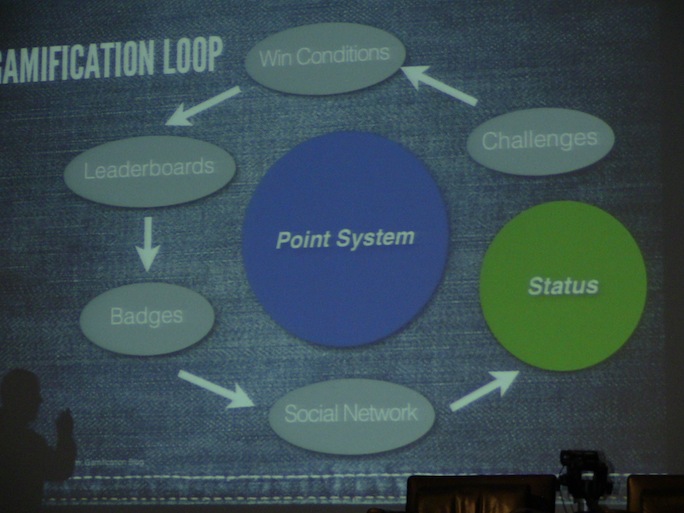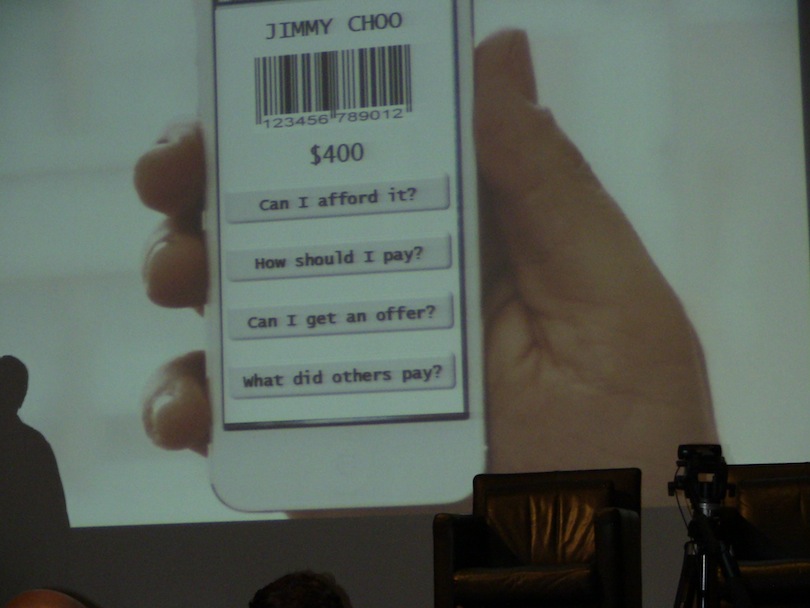The CU Water Cooler Symposium has always been about more than just sharing ideas but actually acting on what you've learned and the connections you've made during the two-day event. The goal is for attendees to return home armed, psyched and ready to implement even just one small change.
That's what we've tried to do with our CU Water Cooler Symposium coverage this year.
We hope you enjoy this quick video before you head on into the more in-depth coverage of the event held Oct. 4-5 in the Frist Center for the Visual Arts in Nashville, Tenn.
We also have to give a huge thanks to everyone behind the scenes at the CU Water Cooler Symposium and especially Tim McAlpine, president/creative director at Currency Marketing for all the photos.
Have Credit Unions Lost Their Souls?
Have credit unions lost their souls?
That's just one of the questions Keith Leggett, vice president and senior economist at the American Bankers Association, said the industry as a whole had to consider.
In his talk to the CU Water Cooler Symposium, he lauded credit unions for their brand of “you belong” but challenged them to really think about what that means?
“What is the value of ownership in a credit union?” said Leggett during his session at the two-day CU Water Cooler Symposium. “What is it you get to exercise as an owner outside of voting for a board of directors? When you look at that ownership stake you can't transfer it, can't sell it, can't take it with you. So while you give a great PR line that you own us I don't see anything being concrete with regard to ownership. On top of that do you treat your members as owners?”
If members were truly owners, he challenged credit unions to voluntarily disclose a material event, significant loss in loans or regulatory enforcement action.
“Publicly traded banks have to make these disclosures if they have 2,000 shareholders,” said Leggett. “How many credit unions here have 2,000 or more members? So what happened is that you are really keeping members in the dark, treating them like mushrooms. So 'you belong' is great PR but you don't go further and treat them like owners.”
In a survey conducted by the ABA, while consumers generally trusted credit unions more than banks and felt like a person rather than a number, their perception was also that in terms of convenience and access credit unions were “worn rugs rather than marble floors,” Leggett said.
“In an earlier session it was said credit unions had to be the expertise providers,” said Leggett. “How are you going to become that if people perceive you as being the worn rugs, which I took to mean that credit unions don't offer that type of sophistication that people would need or would go to get advice.”
He further suggested that the tax exempt status has actually been holding credit unions back from serving their members more effectively in a relevant way.
“Whenever you have a bank and credit union industry get together the conversation always turns to the 800-pound gorilla in the room: taxation. For our Canadian friends, since 1974 recognize that it is just part of the cost of doing business,” said Leggett.
“CUNA loves to say credit unions are tax exempt because of their cooperative structure, they are democratically controlled and their volunteer board members. They cite a finding by Congress from the credit union membership act however they seem to forget about this finding has a conjunction 'and' in there when talking about tax exemption,” he said.
“It's that you are providing credit and meeting saving needs of consumers especially those of modest means. They never want to talk about that, their social mission,” Leggett said.
To Leggett, the credit union industry in the U. S. already has a regulatory tax, in the form of limitations.
“Look at business lending. The is now the fifth Congress in a row where the credit union industry in the U.S. looks to get expanded business lending authority. Its odds are 98% against this legislation ever becoming law in this Congress,” said Leggett.
He suggested the industry has been headed down the same path as the savings and loans some 60 years ago when they lost their tax exempt status.
“When you say anyone with a heartbeat can be a member for $10 or $20 'donation', you've lost your souls because it's a movement away from the core value of credit unions. There is no common bond in a $20 bill,” said Leggett.
“Our view is that the vast majority of credit unions, the smaller ones in the U.S. should preserve tax exemption because they are more likely fulfilling their public policy mission. “
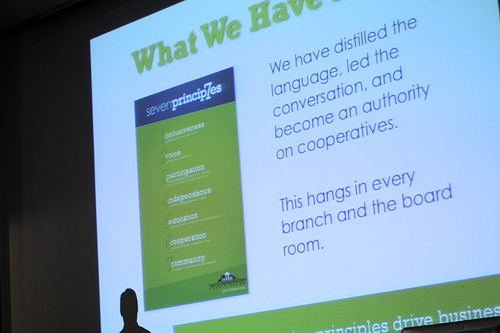
Here are the ways Seattle Metropolitan CU stands out as a cooperative authority in the community.
Now is the Time to Stress the Cooperative Difference
Now is the time to live and play up the cooperative nature of credit unions was the message delivered by a few speakers at the CU Water Cooler Symposium.
Since 2008, Seattle Metropolitan Credit Union has been distinguishing itself from other financial institutions by playing up that it's a cooperative.
According to Andy Wright, assistant vice president of marketing at the Seattle credit union, aligning the culture, marketing and living the seven cooperative principles has helped grow networks and reach different audiences.
“It can be a great differentiator but it has to line up with reality. It can't just be something made up by marketing,” said Wright.
A “Co-opalooza” event, designed to celebrate community and co-ops, has helped build awareness not just of SMCU but also of co-ops in general. Some 20 co-ops participated in the event which included music and special kids activities.
“It's helped us communicate in a different space because of we share the same values,” said Wright. “Just be ready to become the lender of record for other co-ops.”
Gene Blishen, general manager at Mount Lehman Credit Union in British Columbia, said that cooperative spirit can also help small credit unions think big.
“Make the seven cooperative principles a part of your DNA. Every credit union has a core of people who understand,” said Blishen. “Stand for something, know who you are and understand your history. Be authentic and know your market and members. Dealing with people and money gets stressful so you've got to have fun otherwise it becomes problematic.”
He added that smaller credit unions need to find more opportunities to collaborate to create new experiences for old products or even to think more in terms of delivery.
“The good credit unions do is fragile and must be protected. You can mitigate risk by defining your own terms and changing your perspective,” said Blishen. “Don't be afraid to fail, because that just gives you an opportunity to do something in a different way. I'm just a hired gun. A huge element of this understanding of your membership is talking to them and listening. You don't always have to listen to the experts because you've got resident experts. Filter your decisions by using the seven principles and maybe consider what could be an eighth. Is seven enough? ”
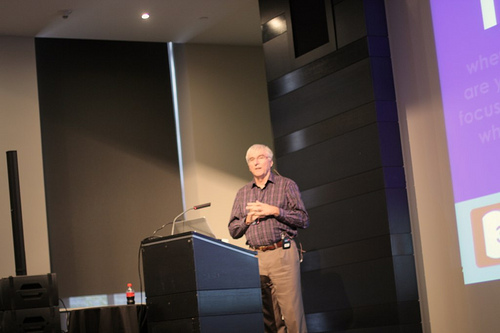
Gene Blishen is with Mount Lehman Credit Union in British Columbia.
Be Young and Free, But Don't Be Cheesy
The generation that grew up watching their parents hanging up on telemarketers isn't interested in being overtly sold to.
Two of Currency Marketing's Young & Free spokesters – Austin Chapman and Kylie Keene – shared a few insights into reaching the next generation.
Forget about youth programs that span from 13 to 25.
“High schoolers don't want to hang with junior high kids and college students don't want to be grouped with high school or junior high kids,” Chapman said of the one size fits all approach.
In addition, mobile is huge said Keene, especially for college students.
“Our schedules are crazy and the ability to see instantly where our money is going is most important, but it's got to be easy. We don't want to have to jump through hoops so just keep it simple,” said Keene.
While credit unions still suffer from the perception that it's a place for parents or grandparents, Keene and Chapman agreed that there is hope.
“If you can get past the noise or the idea that you are just selling to us or trying to scam us, once we understand that there is a difference we'll share that with our friends,” said Chapman.
Games People Play
When Tim McAlpine, president/creative director of Currency Marketing and man behind the Young & Free program, opened the CU Water Cooler Symposium, it was literally game on.
So this year, the 125 attendees gathered at the Frist Center for the Visual Arts were issued a gaming challenge for prizes ranging from Brent Dixon's new “Cradle to Cradle” album and variety of cool gadgets, to an interactive badge granting access to SXSW.
The true top prize? Becoming a CU Water Cooler editor, who in addition to blogging, sharing their daily links of what they're reading, will have the opportunity to speak at the next symposium.
The true goal? To get people exploring, thinking and networking/collaborating in a new way to get things done; basically living the whys behind McAlpine and Matt Davis, director of innovation at Filene Research Institute launching the CU Water Cooler and Symposium three years ago.
For Davis, it was also a great way to demonstrate the opportunity that game thinking presents as a way to engage consumers and solve problems.
Looking at the success of Farmville, Weight Watchers, Biggest Loser and Nike+, Davis said it boiled down to an understanding of the gamification loop, which starts with a point system and letting players know what they need to do. From there they are given challenges, win conditions, leaderboards to know how they are doing in comparison to others, badges to encourage/reward play and social network and it all combines and results in status.
“That's powerful. So a lot of us might have made fun of people who played Farmville but 83 million people played it,” said Davis. “They made a game about farming, which I can tell you, from personal experience there is nothing fun about farming. So how can credit unions use game thinking and fun to apply to financial services?”
With credit unions doing a really bad job of capturing people's attention, Davis said, gamification represents an opportunity to deliver more value to members.
“If you want to engage members, solve problems, do it by having fun at the center of it all,” he said.
According to Davis, it's in the creation of the gamification flow channel that credit unions have the potential to make the most impact.
“It's the connection between skill and challenge level. So we try to create solutions in financial services that treat everyone as if they are at the same level so everyone has the exact same experience. The truth is we are all very different, with different skill levels,” said Davis. In games, at each level the challenges become progressively harder because the players skills should be improving.
“This is where our head should be at in terms of gamification,” said Davis. “If we can do a better job of matching skill sets with challenges that are just out of reach, it gets people to work harder to be better and their skill set goes up without them being anxious or bored.
“So often the onboarding process is thought of in terms of how can I get deeper share of wallet. What I suggest to you is to find what the skill level is and walk through the description of product and service sign up as a way to understand and maximize the value of what they are getting.”
Each task was assigned a range of points, and while for the most part honor-based, ultimate verification happened on Twitter. If it wasn't posted, then it didn't happen. During the two-day event, the #cuwcs hashtag was used more than 4,000 times said McAlpine.
The winners were as follows:
Team Green won Brent Dixon's new Cradle to Cradle album with 3,705 points. With 760 points, Adam Monteith won an Apple TV; 870 points landed Rebecca Alcorn a set of Bose in-ear headphones; Blake Reynolds' 1,130 points earned him a Jambone Jambox. With 1,210 points Charles Parr will be headed to 2013 SXSW and Amy Etheridge was the grand prize winner. She had 2,015 points and as a CU Water Cooler editor will speak at the 2013 CU Water Cooler Symposium.
In addition to Etheridge, with former editors Carla Day, Christopher Morris and Kelley Parks retiring, Matt Monge, Rob Rutkowski, Shari Storm and CU Times Editor/Publisher Sarah Snell Cooke were unveiled as new CU Water Cooler editors.

Brent Dixon on Transformation and Thinking Big
Thinking on a larger scale was the overarching message of Brent Dixon's session that kicked off the CU Water Cooler Symposium at the Frist Center for the Visual Arts in October.
The Austin, Texas-based founder of The Cooperative Trust shared quite a few facts but the one that seemed to strike a chord with attendees most was that there are more payday lenders in the U.S. than Starbucks and McDonald's put together.
In addition, it turns out that one of the top reasons why people go to payday lenders is actually in a roundabout way because of the fees.
The upfront, clearly spelled out charges, even if they are predatory and making the choice to do so, seems preferable to dealing with a financial institution where fees will be snuck in, Dixon said.
“There's an opportunity to disrupt the current credit union system gatekeepers of Experian, Transunion and Equifax to grant access to credit,” Dixon added. “FICO is a really bad risk assessment tool so how do we come up with new models?”
He pointed to Zest Finance as an example of a new approach to underwriting. Using large-scale, big-data analyzing variables from financial information to technology usage has resulted in the ability to extend credit to 25% more Americans, Dixon said.
He added that the anti-banking industry sentiment has not moved on and that before credit unions laugh thinking it's banks, credit unions are included in that group as people don't distinguish between credit unions and banks.
“Finance, consumer finance can be a transformative tool. And credit unions with their structure and philosophy can be a tool bucket in which you can use some of these exponential technologies and use consumer finance to solve some of the world's biggest challenges. And that has to be the future of consumer finances,” said Dixon. “Things are broken and we are the people who are called to fix it.”
With access to capital as the lubricant to the economy Dixon pointed out that people have come up with new ways of doing that from peer-to-peer lending, which is essentially a technological take on the credit union model, crowdfunding like Kickstarter.com and alternative currency like time and expertise being traded for mutual benefit.
“A friend of mine needed $5,000 to launch his album. He put it on Kickstarter and had a series of goals matched to donation amounts and in one week got $5,000 he didn't have to pay back,” said Dixon. “In New York, alternative currency where say a nurse would give an hour of me being a nurse in exchange for an hour of you being a plumber, became so popular they tried to tax it as income.”
For Dixon, the World Council of Credit Unions has been a picture of what development and transformative work looks like in credit unions.
“Opportunities exist to increase access. 2.5 billion people are unbanked, there's one simple opportunity to positively impact access to credit, savings peace of mind,” he said.
He added that kind of thinking shouldn't just be limited to underdeveloped countries and there has been a demonstrated need present in developed countries as well.
Also sorely in need of a large-scale makeover? Collaboration among credit unions in the U.S.
“Desjardins in Canada has helped credit unions claim 40% of market share in Quebec,” said Dixon. “Compare that to our fragmented collaboration in the U.S., which has 6% of market share. There's opportunity to do more. The Occupy movement was a disruptive tool for social change. We all want to change something. Credit unions have the ability to change something in consumer finance if we act on what we say we are built upon. So what does the future of consumer finance look like? Are credit unions positioned to make it happen?”
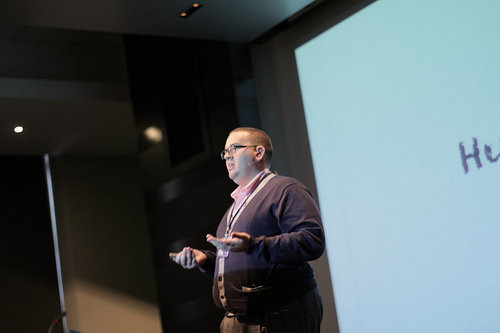
It's All in the Delivery
Don't be quick to write off humor or underestimate the power of a joke in telling a story or making a point.
What if the secret to getting someone as member started with a joke?
For Jimmy Marks, creative media director at DigitalMailer in suburban Virginia, the roots of his appreciation for humor sprang from the loss of his grandfather when he was a child.
To help his son smile again, Marks' father told him a pig joke and he laughed. Fast forward to his first acting gig in “The Music Man” at 8 years old, one standing ovation later, he was hooked and became a student and some would say now, master of humor.
“Every laugh you've ever laughed, you laughed in the face of death,” said Marks, recognizing that it was a bit of a downer. “The scariest thing is the door that needs to be opened and the laughs remind us we are alive. It energizes me and gives me a good feeling.”
Some of the simple lessons of humor such as audience is everything, can also be applied to delivering the credit union message more effectively perhaps with even more authenticity.
“Timing matters as is recognizing when it is and isn't appropriate for a joke. In a play you can't be in every scene so you have to make your scene count,” said Marks. “In improv you're not allowed to reject what's given to you in a scene. You can't shoot down an idea you have to build on it. If you can, go to a local college and have an improv group to teach you something. Humor helps you socialize, remember details of life and makes you aware.”
Whether it's writing, a project or an idea if it's never shared or shown to others what good is it? Marks said if no one shows up or responds to it then it wasn't geared to the right audience.
I would not be standing here if not for Twitter,” said Marks. “I think about 60% of the time Facebook is ridiculous and I don't like LinkedIn or Pinterest but Twitter, that was the place I could be goofy. If it runs longer than 140 characters, either write a blog, delete or edit to make it fit.”
When Joan Rivers started doubting herself and wondered if she should change her act because she was a woman and was not widely accepted, Bill Cosby advised her not to change because if only 1% ofAmerica loved her she'd fill stadiums for the rest of her life. Marks said the credit union industry and individuals alike can benefit from that lesson of having the commitment and fearlessness to stay true to themselves.
“My heroes were outsiders. Comedians break patterns all the time,” said Marks. “Dave Chappelle walked away from $50 million to stay true to himself. He's still performing his way without all the roadblocks to doing that. To be a comedian Bill Murray said 'You've gotta go out there and be completely unafraid to die. You've got to be able to take a chance to die, and you have to die lots.'”
The same could be said for credit unions. To be bold enough to identify their community and the people they want to be in touch with and vice versa. The same sense of belonging that serves as the foundation for an inside joke can play into more meaningful, engaged interactions.
“Funny takes work and sincerity is fuel for the fire. I don't put anything on Twitter that I didn't want to be there and that is manicured. There's a lot of stuff I don't put on Twitter,” said Marks. “Hank Williams said what makes country music so successful can be explained in just one word-sincerity. It's the same with humor, it has to go deep in the gut sincere. It doesn't just fall out of the sky. If you can't be funny, then be sincere. Sincerity was the reason behind my father telling me that pig joke. He just wanted his son to stop crying. So what if the key to telling members a concise, understandable story that they could connect with and relate to actually started with a joke?”
This represents the new moment of opportunity for credit unions to add value with new products and services that members actually want.
Turn Your Business Model on its Head
Credit unions interested in thriving, distinguishing and differentiating themselves in the financial services arena must turn their current business model on its head.
“The current business model is dead, dying and you need a new one to reboot for the 21st century,” Ron Shevlin, senior analyst at the Boston-based Aite Group, told attendees at the CU Water Cooler Symposium.
He pointed to declining return on equity, which for the financial services industry as whole has hovered at about 8% since dropping from an industry high of 13-15% from 1993-2007. For credit unions in particular there has been a decline in overall gross income, with revenue falling nearly 4% during a period when membership was actually growing.
“Those are warning signs and growth, cost reduction and pricing changes aren't going to cut it,” said Shevlin. “I don't think today's business model is going to provide the engine to get us back to historical levels of ROE. We as a society have changed and the paradox here is as we become a more highly educated, affluent, self-service do-it-yourself, few of us are actively managing our financial lives.”
According to Shevlin, across the generations three in 10 have simply not been involved in their financial lives. Gen Y at 33%, turned out to be the most highly engaged in their financial lives, he said.
He added that over the next few years there will be three big changes in the financial services industry: the death of checking accounts, separation of production and distribution, and a refocus on financial performance.
“For the first time in 60 years, it's not a given that when individuals reach adult age they will open a checking account. There is a new set of consumers, highly educated consumers who are working or if they aren't working it's because they are still in school, choosing to opt out of the traditional banking system, which includes credit unions,” said Shevlin.
“I call them the debanked. So while you are patting yourselves on the back for the 650,000 consumers who switched during Bank Transfer Day, there are 15 million who have left or are about leave. There's a need for a new type of account.”
For example, Movenbank created the concept of CRED as an alternative to a FICO score, so consumers have a single account that evolves based not on their credit worthiness but debit worthiness. Blending prepaid, credit and debit capabilities, as their CRED score goes up, customers get additional capabilities that grow with their needs.
He added that credit unions need to think beyond the old moments of opportunity under the save and borrow focus such as having a new baby, or needing a car loan to the new opportunities emerging from a new focus on advise and perform. Given the availability of technology and a new more highly engaged generation, the financial services industry can add more value.
“We couldn't get to that advice reform of quantifying how consumers are doing in their financial lives before now,” said Shevlin. “We need to get beyond just personal financial management to financial performance management. People need to know how much have you helped them save and tracking that, how is their money doing and what should they do with it? “You have an important decision to make: What is your credit union business model going to be for the 21st century because today's business model isn't working.”
Below, Ron Shevlin of Aite Group makes his case at the CU Water Cooler Symposium.
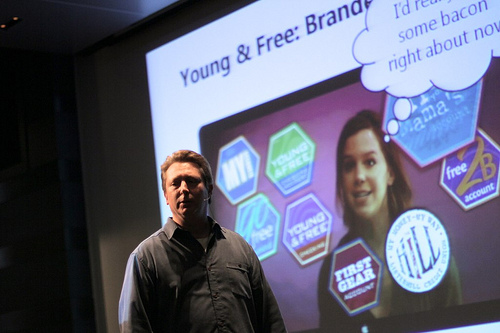
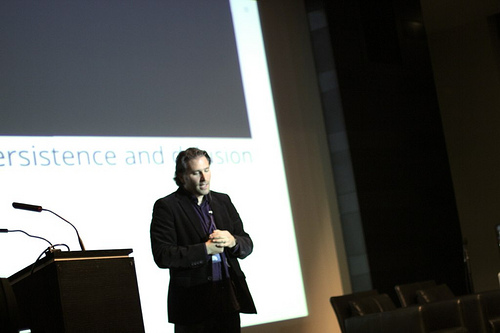
Filmmaking Lessons on Leadership
An underlying theme at the CU Water Cooler Symposium was challenging attendees to think in new ways about common challenges through discussions of seemingly disparate concepts.
William Azaroff, director, business/ community development at Vancouver, British Columbia-based Vancity, continued along those lines with leadership tips drawn from filmmaking.
The essence of filmmaking boils down to creativity within limits.
“If you say go innovate, it's paralyzing,” said Azaroff. “Setting that one limitation maybe business model or geographic region can free up so many ideas so you can innovate to get to what your trying to do in your organization.
“Give people a safe place to take risks and yes there will be failures along the way. You couldn't make a film and not expect to be bad takes.”
The difference between films that got made and those that didn't was the drive of the people involved, Azaroff said. He said he found that people worked their best on a project they believed in, the same holds true for credit union staffers.
“Our mission is an advantage. People want to do interesting work and be a part of an organization steeped in mission,” said Azaroff. “People need clear direction you've got to communicate beyond the page. You always hear 'hire people who are more talented than you.' I say hire those who are differently talented, who offer different perspectives. Bring creative and tech people together to collaborate and work to solve problems.”
Azaroff shared a story about a friend he recently reconnected with ho was still pursuing a dream of being a screenwriter after more than 10 years of failing.
“I thought how sad, she's just deluding herself. Then a few years ago, one of her scripts was bought by a really well-known director, and then another got picked up and now she's being hired to write an original screen play. So what looked to me like delusion turned out to be persistence. How does the credit union industry strike the balance between delusion and persistence?”
If every story has a villain, then apathy has been the credit union industry's greatest villain, Azaroff said.
“Inspiration comes from long slogs. Something that looks easy comes from long thought. I got advice to make the films you want to see. So what's missing from your marketplace?”
Branding Gives Way to Storytelling Gives Way to What?
Forget about branding, storytelling or whatever the next marketing trend may be.
According to David Baker, principal of consulting firm ReCourses Inc., the process has become so watered down that in most cases it's become just a service term geared toward getting money more than delivering results.
“Over last five years have you heard more about branding from marketing firms or farmers,” said Baker to attendees at the CU Water Cooler Symposium. “Have you ever seen farmers brand their cow? Unless your firm or your client smell burning flesh or burning hair and someone is screaming, real branding is not taking place. I believe in a brand but branding as a discipline is dead. Very few do it in a way that matters.”
He added that the brand is important and storytelling may be even more important as it's emotive and tells the fact in a way that consumers are more likely to absorb and connect with. but that only a few people are investing the time and continuous effort that goes into it.
What matters most is for credit unions to think of themselves as not being in the service business but rather the expertise business, Baker said.
“There are three dry cleaners in my neighborhood and if my dry cleaner ticks me off then I'll just go to the drycleaner around the corner. The point is that the only time I care about or notice those in the service business is when they screw up,” said Baker. “If you are in the expertise business that means you are as an institution doing what's right for the consumer even if it means you don't make as much money. So members aren't headed to your credit union just to park their money but because they need answers to something that's important to them.”
One way for that shift to happen starts with having people in the organization who believe in and live the mission.
“With all the homogenous offerings how can financial institutions get back to thinking differently about specialization?” Baker asked. “You want to change the world? Start first with your significant other, next your children, then friends and fourth the people you manage. Very few of us have a huge platform but change how you manage your people and you'll find that those people do a much better job of representing your credit union than any marketing.”
He added that educating consumers in financial literacy is a good start to being in the expertise business as most consumers still aren't able to navigate their finances.
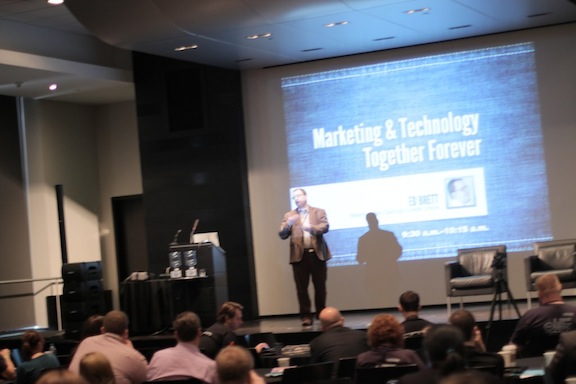
Marketing to Technology: Let's Get Together
Why can't marketing and technology not only get along but work together to solve common consumer concerns?
According to Ed Brett, manager, product and service delivery at British Columbia-based Westminster Savings Credit Union, it's past time to leverage the strengths of both departments to do more for members.
“We need to be sensitive to the way technology is changing our relevance to members,” said Brett. “Alternative lending companies and increasingly media and technology companies are becoming more relevant to the day–to-day financial lives to consumers than we are. Instead of coming to us members move to them for answers on their financial lives. Why does Suze Orman have more influence in our members' lives than our branch managers?”
Brett added that a more symbiotic relationship between IT and marketing departments could help make a real difference. As an example, he pointed to the uselessness of personal financial management as a standalone platform.
“We asked consumers where did you learn how to manage your finances and we thought we'd hear answers like from my parents or financial literacy initiatives but what we actually heard was 'I just had to figure it out on my own,' which meant that they weren't managing their finances at all,” said Brett.
“The value for us here is how to take technology like PFM to add more relevance and value to members' lives,” he said. “We have people in branches who can deliver value through technology to others, we have principles and we can own that. Our stakeholders are the people we serve and this represents an opportunity for us to provide a service they really need, using PFM tools for example, based on why it matters and is important to them.”
He added that IT has been an untapped, underutilized resource and looking ahead there should more of an effort to include technologists in the strategic process.
“Technology should be as involved with upstream decisions as they are with the downstream implementation,” said Brett. “Have them be a part of the discussions and let them take responsibility for the growth strategy in your credit union and be as creative about your credit union as your systems.”
The common challenge with technology and banking has been how to take those concepts that exist as abstracts and make them real.
“The most important part of the Amazon experience for me is not what occurs at the point of purchase but what happens seven days later. There's the package and it's Christmas or my birthday again,” said Brett. “When I was in IT the things that mattered to the organization were abstractions to me especially our members. Two days in the call center cured me. The cool things I was creating didn't matter at all to all these people calling in because it didn't help them. “In general, IT is disconnected from that conversation and that is a risk for your credit union. It's dangerous to have your IT group treat your members as abstractions as well. “
He advised marketers to be excellent observers of the little things.
“Look for ways that members actually use the technology rather than how you want them to,” said Brett. “How you want them to have a relationship with you is not up to you anymore, so you have to start paying attention to what really matters.”
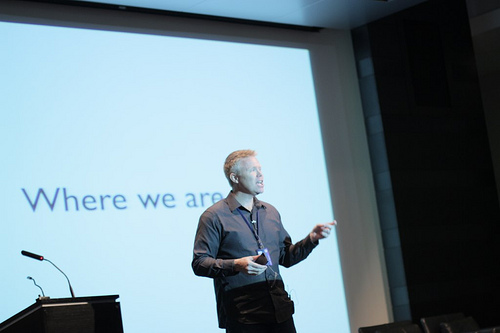
Andy Janning of No Net Solutions makes his point to the CU Watercooler crowd.
Creating Workplace Heroes
To truly build better organizations, focus on helping others evolve.
That was the underlying message delivered by Matt Monge, chief culture officer at Mazuma Credit Union, and Andy Janning, president/CEO of No Net Solutions, during the CU Water Cooler Symposium.
“We can't think of employee development as exclusive to a department or one person, “ said Monge. “It has to be more than that. It has to be the organization's way of life, be baked into the culture that it is a community effort on the part of everyone there.
“If you don't do that and reduce it to just a department you'll have at best mediocre development of folks.”
Janning added that every employee is a hero to someone and there is nobility in helping someone evolve.
“We've got to completely rethink the role of people in employee development, it's not an exact science and is designed to be imperfect. The way it's done now implies an endpoint, which doesn't exist,” said Janning. “Every hero story ever told on earth, there is always a trainer figure, always a point where the hero messes up. Each of you are experts in something. Each one of you can make someone else better.”
He said it's the job of the organization to pay attention to helping the employees, who essentially hold up the walls of credit unions, evolve and to make those subject matter experts shine.
Monge added that it's time to stop holding the training department more accountable for employee development than their managers.
“Sending employees to a training session, a conference or even sending them a link to an article is not developing them,” said Monge. “What if we make it not OK for leaders not to lead their people by asking them what specifically have you done to help develop their dreams?”
He added that development is not just for front-line employees.
“Consider the fact that if employees are not seeking it out, not growing, it could be because they don't see any of us doing it. The discussion they usually have is, 'Here sign this paper that we had a conversation,'” said Monge. “We've got to be doing better than that. They should see their managers go out to pursue their own development and be modeling that learning and growing never ends. We have to stop this idea where employee development is teaching front line staff.”
The academia model of studying to pass a test cannot be applied effectively in helping employees evolve in the workplace, the speakers said.
“No one ever learned to ride a bike in a workshop,” said Janning. “Knowledge is not power. Performance is power. We need to stop making knowledge something that only the gatekeepers of an organization have. People go to programs for one goal paycheck improvement.
“They want to do more so they can go home whole, healthy, happy and be the hero to the people who greet them at the door. The space organizations need to be in is to help employees evolve through KPP – knowledge, practice and performance.
“To screw up safely is part of the job, not to pass the test but practice effectively and measure performance. We can each make someone better. It starts with how are we developing employees? How are we making them heroes?”
Below, Matt Monge of Mazuma Credit Union says employee development must cross departmental lines.
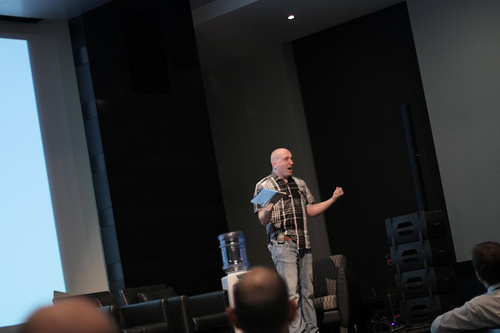
© 2025 ALM Global, LLC, All Rights Reserved. Request academic re-use from www.copyright.com. All other uses, submit a request to [email protected]. For more information visit Asset & Logo Licensing.


